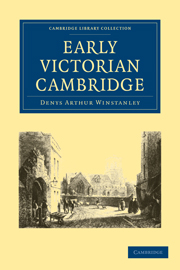Book contents
- Frontmatter
- Contents
- Preface
- Chapter I THE FOUNDATION OF DOWNING COLLEGE
- Chapter II A COLLEGE ELECTION
- Chapter III UNDERGRADUATES IN BONDS
- Chapter IV THE ATTACK ON HEADS OF HOUSES
- Chapter V CHRISTOPHER WORDSWORTH
- Chapter VI THE RELIGIOUS TESTS
- Chapter VII CHANCELLORS AND HIGH STEWARDS
- Chapter VIII TOWN AND GOWN
- Chapter IX TROUBLE AT THE FITZ WILLIAM
- Chapter X INTERNAL REFORM
- Chapter XI THE ROYAL COMMISSION
- Chapter XII BETWEEN THE TWO COMMISSIONS
- Chapter XIII STATUTE XLI AND THE THREE REGIUS PROFESSORSHIPS
- Chapter XIV THE STATUTORY COMMISSION AND THE UNIVERSITY
- Chapter XV THE STATUTORY COMMISSIONERS AND TRINITY COLLEGE
- Chapter XVI CAMBRIDGE AS IT WAS
- Appendices
- A Fellowships of Trinity College
- B The Trinity Seniority
- C Sir Isaac Newton's rooms
- D The statue of Isaac Barrow in Trinity Chapel
- Index
D - The statue of Isaac Barrow in Trinity Chapel
Published online by Cambridge University Press: 07 September 2010
- Frontmatter
- Contents
- Preface
- Chapter I THE FOUNDATION OF DOWNING COLLEGE
- Chapter II A COLLEGE ELECTION
- Chapter III UNDERGRADUATES IN BONDS
- Chapter IV THE ATTACK ON HEADS OF HOUSES
- Chapter V CHRISTOPHER WORDSWORTH
- Chapter VI THE RELIGIOUS TESTS
- Chapter VII CHANCELLORS AND HIGH STEWARDS
- Chapter VIII TOWN AND GOWN
- Chapter IX TROUBLE AT THE FITZ WILLIAM
- Chapter X INTERNAL REFORM
- Chapter XI THE ROYAL COMMISSION
- Chapter XII BETWEEN THE TWO COMMISSIONS
- Chapter XIII STATUTE XLI AND THE THREE REGIUS PROFESSORSHIPS
- Chapter XIV THE STATUTORY COMMISSION AND THE UNIVERSITY
- Chapter XV THE STATUTORY COMMISSIONERS AND TRINITY COLLEGE
- Chapter XVI CAMBRIDGE AS IT WAS
- Appendices
- A Fellowships of Trinity College
- B The Trinity Seniority
- C Sir Isaac Newton's rooms
- D The statue of Isaac Barrow in Trinity Chapel
- Index
Summary
Roubiliac's statue of Sir Isaac Newton, presented in 1755 by Dr Robert Smith, stood alone at the west end of the ante-chapel of Trinity until a statue of Lord Bacon, given by Whewell shortly after he became Master, was placed on its right. The addition of Bacon was an artistic blunder, as it obscures the beauty of the Newton statue; and it unfortunately occasioned another.
“The last time I was within the walls of Trinity College,” wrote Lord Lansdowne to Whewell on 24 November 1856, “after the statue of Lord Bacon had by your liberality and exertion been compleated (sic) and placed in the situation it now fills in the antichapel (sic) where that of Newton had long been seen, I could not help considering whether the history of English literature and philosophy could produce a name representing a genius so exalted as to be worthy of such companionship, and as such fitted to fill the corner which now appears to be left vacant on the opposite side. But one occurred, or would, I think, occur 10 others engaged in the same consideration, with the exception indeed of another which has no academic associations–that of Milton. …
- Type
- Chapter
- Information
- Early Victorian Cambridge , pp. 436 - 440Publisher: Cambridge University PressPrint publication year: 2009First published in: 1940



